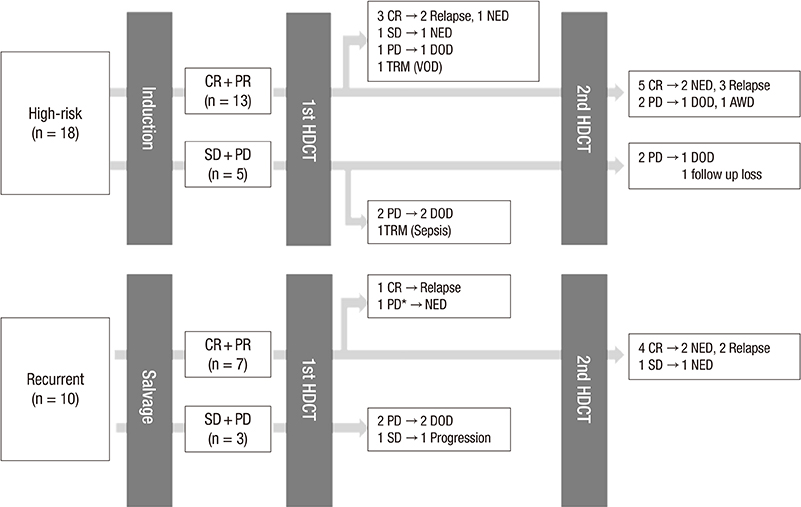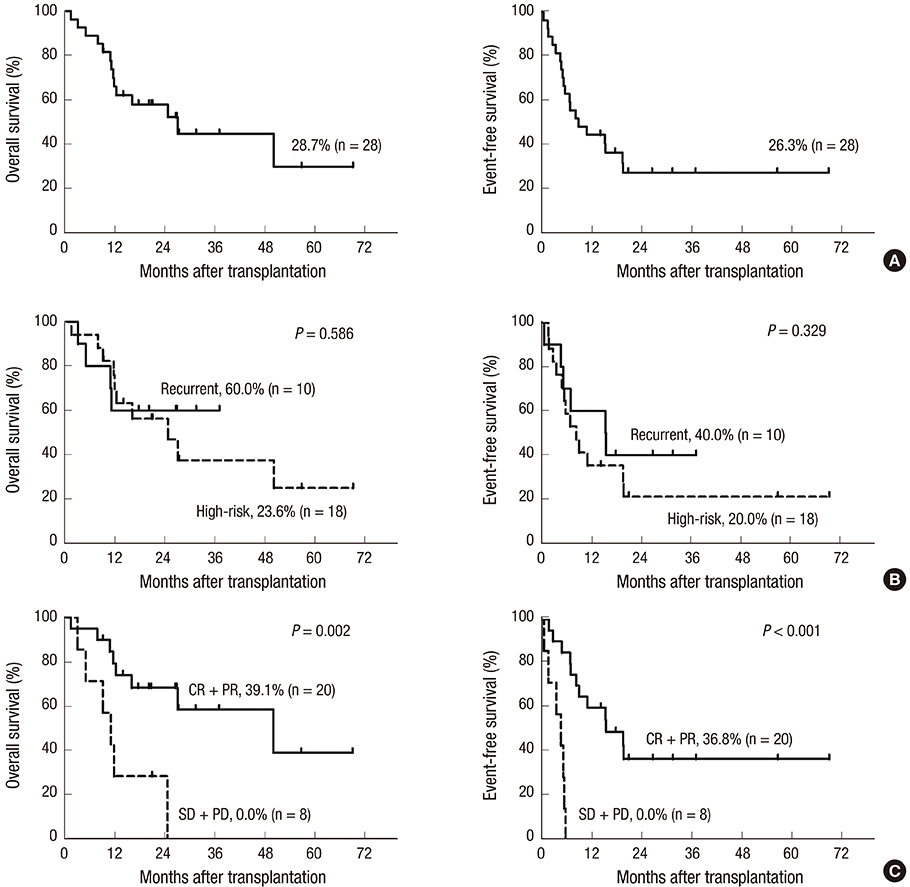J Korean Med Sci.
2016 Jul;31(7):1055-1062. 10.3346/jkms.2016.31.7.1055.
High-Dose Chemotherapy and Autologous Stem Cell Transplantation in Children with High-Risk or Recurrent Bone and Soft Tissue Sarcomas
- Affiliations
-
- 1Department of Pediatrics, Chung-Ang University Hospital, Seoul, Korea.
- 2Department of Pediatrics, Samsung Medical Center, Sungkyunkwan University School of Medicine, Seoul, Korea. leejw.lee@samsung.com
- KMID: 2373723
- DOI: http://doi.org/10.3346/jkms.2016.31.7.1055
Abstract
- Despite increasing evidence that high-dose chemotherapy and autologous stem cell transplantation (HDCT/auto-SCT) might improve the survival of patients with high-risk or recurrent solid tumors, therapy effectiveness for bone and soft tissue sarcoma treatment remains unclear. This study retrospectively investigated the feasibility and effectiveness of HDCT/auto-SCT for high-risk or recurrent bone and soft tissue sarcoma. A total of 28 patients (18 high-risk and 10 recurrent) underwent single or tandem HDCT/auto-SCT between October 2004 and September 2014. During follow-up of a median 15.3 months, 18 patients exhibited disease progression and 2 died of treatment-related toxicities (1 veno-occlusive disease and 1 sepsis). Overall, 8 patients remained alive and progression-free. The 3-year overall survival (OS) and event-free survival (EFS) rates for all 28 patients were 28.7% and 26.3%, respectively. In the subgroup analysis, OS and EFS rates were higher in patients with complete or partial remission prior to HDCT/auto-SCT than in those with worse responses (OS, 39.1% vs. 0.0%, P = 0.002; EFS, 36.8% vs. 0.0%, P < 0.001). Therefore, careful selection of patients who can benefit from HDCT/auto-SCT and maximal effort to reduce tumor burden prior to treatment will be important to achieve favorable outcomes in patients with high-risk or recurrent bone and soft tissue sarcomas.
Keyword
MeSH Terms
-
Adolescent
Antineoplastic Combined Chemotherapy Protocols/*therapeutic use
Bone Neoplasms/mortality/pathology/*therapy
Child
Child, Preschool
Disease-Free Survival
Female
Follow-Up Studies
Humans
Infant
Male
Retrospective Studies
Sarcoma/mortality/pathology/*therapy
Soft Tissue Neoplasms/mortality/pathology/*therapy
*Stem Cell Transplantation
Survival Rate
Transplantation, Autologous
Treatment Outcome
Young Adult
Figure
Reference
-
1. HaDuong JH, Martin AA, Skapek SX, Mascarenhas L. Sarcomas. Pediatr Clin North Am. 2015; 62:179–200.2. Grier HE, Krailo MD, Tarbell NJ, Link MP, Fryer CJ, Pritchard DJ, Gebhardt MC, Dickman PS, Perlman EJ, Meyers PA, et al. Addition of ifosfamide and etoposide to standard chemotherapy for Ewing's sarcoma and primitive neuroectodermal tumor of bone. N Engl J Med. 2003; 348:694–701.3. Meyers PA. High-dose therapy with autologous stem cell rescue for pediatric sarcomas. Curr Opin Oncol. 2004; 16:120–125.4. Miser JS, Krailo MD, Tarbell NJ, Link MP, Fryer CJ, Pritchard DJ, Gebhardt MC, Dickman PS, Perlman EJ, Meyers PA, et al. Treatment of metastatic Ewing's sarcoma or primitive neuroectodermal tumor of bone: evaluation of combination ifosfamide and etoposide--a Children's Cancer Group and Pediatric Oncology Group study. J Clin Oncol. 2004; 22:2873–2876.5. Weigel BJ, Lyden E, Anderson JR, Meyer WH, Parham DM, Rodeberg DA, Michalski JM, Hawkins DS, Arndt CA. Intensive multiagent therapy, including dose-compressed cycles of ifosfamide/etoposide and vincristine/doxorubicin/cyclophosphamide, irinotecan, and radiation, in patients with high-risk rhabdomyosarcoma: a report from the Children's Oncology Group. J Clin Oncol. 2016; 34:117–122.6. Kim NK, Kim HS, Suh CO, Kim HO, Lyu CJ. Clinical results of high-dose chemotherapy followed by autologous peripheral blood stem cell transplantation in children with advanced stage rhabdomyosarcoma. J Korean Med Sci. 2012; 27:1066–1072.7. Park JE, Kang J, Yoo KH, Sung KW, Koo HH, Lim DH, Shin HJ, Kang HJ, Park KD, Shin HY, et al. Efficacy of high-dose chemotherapy and autologous stem cell transplantation in patients with relapsed medulloblastoma: a report on the Korean Society for Pediatric Neuro-Oncology (KSPNO)-S-053 study. J Korean Med Sci. 2010; 25:1160–1166.8. Frei E 3rd, Canellos GP. Dose: a critical factor in cancer chemotherapy. Am J Med. 1980; 69:585–594.9. Burke MJ, Walterhouse DO, Jacobsohn DA, Duerst RE, Kletzel M. Tandem high-dose chemotherapy with autologous peripheral hematopoietic progenitor cell rescue as consolidation therapy for patients with high-risk Ewing family tumors. Pediatr Blood Cancer. 2007; 49:196–198.10. Loschi S, Dufour C, Oberlin O, Goma G, Valteau-Couanet D, Gaspar N. Tandem high-dose chemotherapy strategy as first-line treatment of primary disseminated multifocal Ewing sarcomas in children, adolescents and young adults. Bone Marrow Transplant. 2015; 50:1083–1088.11. Nath SV, Prince HM, Choong PF, Toner GC. Durable remissions are rare following high dose therapy with autologous stem cell transplantation for adults with “paediatric” bone and soft tissue sarcomas. Int Semin Surg Oncol. 2005; 2:12.12. Kasper B, Lehnert T, Bernd L, Mechtersheimer G, Goldschmidt H, Ho AD, Egerer G. High-dose chemotherapy with autologous peripheral blood stem cell transplantation for bone and soft-tissue sarcomas. Bone Marrow Transplant. 2004; 34:37–41.13. Meyers PA, Krailo MD, Ladanyi M, Chan KW, Sailer SL, Dickman PS, Baker DL, Davis JH, Gerbing RB, Grovas A, et al. High-dose melphalan, etoposide, total-body irradiation, and autologous stem-cell reconstitution as consolidation therapy for high-risk Ewing's sarcoma does not improve prognosis. J Clin Oncol. 2001; 19:2812–2820.14. Sauerbrey A, Bielack S, Kempf-Bielack B, Zoubek A, Paulussen M, Zintl F. High-dose chemotherapy (HDC) and autologous hematopoietic stem cell transplantation (ASCT) as salvage therapy for relapsed osteosarcoma. Bone Marrow Transplant. 2001; 27:933–937.15. Berthold F, Boos J, Burdach S, Erttmann R, Henze G, Hermann J, Klingebiel T, Kremens B, Schilling FH, Schrappe M, et al. Myeloablative megatherapy with autologous stem-cell rescue versus oral maintenance chemotherapy as consolidation treatment in patients with high-risk neuroblastoma: a randomised controlled trial. Lancet Oncol. 2005; 6:649–658.16. George RE, Li S, Medeiros-Nancarrow C, Neuberg D, Marcus K, Shamberger RC, Pulsipher M, Grupp SA, Diller L. High-risk neuroblastoma treated with tandem autologous peripheral-blood stem cell-supported transplantation: long-term survival update. J Clin Oncol. 2006; 24:2891–2896.17. Matthay KK, Villablanca JG, Seeger RC, Stram DO, Harris RE, Ramsay NK, Swift P, Shimada H, Black CT, Brodeur GM, et al. Treatment of high-risk neuroblastoma with intensive chemotherapy, radiotherapy, autologous bone marrow transplantation, and 13-cis-retinoic acid. N Engl J Med. 1999; 341:1165–1173.18. Pritchard J, Cotterill SJ, Germond SM, Imeson J, de Kraker J, Jones DR. High dose melphalan in the treatment of advanced neuroblastoma: results of a randomised trial (ENSG-1) by the European Neuroblastoma Study Group. Pediatr Blood Cancer. 2005; 44:348–357.19. Sung KW, Lee SH, Yoo KH, Jung HL, Cho EJ, Koo HH, Lee SK, Kim J, Lim DH, Suh YL, et al. Tandem high-dose chemotherapy and autologous stem cell rescue in patients over 1 year of age with stage 4 neuroblastoma. Bone Marrow Transplant. 2007; 40:37–45.20. Sung KW, Lim H, Lee SH, Yoo KH, Koo HH, Kim JH, Suh YL, Joung YS, Shin HJ. Tandem high-dose chemotherapy and autologous stem cell transplantation for anaplastic ependymoma in children younger than 3 years of age. J Neurooncol. 2012; 107:335–342.21. Sung KW, Son MH, Lee SH, Yoo KH, Koo HH, Kim JY, Cho EJ, Lee SK, Choi YS, Lim DH, et al. Tandem high-dose chemotherapy and autologous stem cell transplantation in patients with high-risk neuroblastoma: results of SMC NB-2004 study. Bone Marrow Transplant. 2013; 48:68–73.22. Matsubara H, Makimoto A, Higa T, Kawamoto H, Takayama J, Ohira M, Yokoyama R, Beppu Y, Takaue Y. Possible benefits of high-dose chemotherapy as intensive consolidation in patients with high-risk rhabdomyosarcoma who achieve complete remission with conventional chemotherapy. Pediatr Hematol Oncol. 2003; 20:201–210.23. Rosenthal J, Bolotin E, Shakhnovits M, Pawlowska A, Falk P, Qian D, Oliver C, Sato J, Miser J, Forman S. High-dose therapy with hematopoietic stem cell rescue in patients with poor prognosis Ewing family tumors. Bone Marrow Transplant. 2008; 42:311–318.24. Hong CR, Kang HJ, Kim MS, Ju HY, Lee JW, Kim H, Kim HS, Park SH, Park KD, Park JD, et al. High-dose chemotherapy and autologous stem cell transplantation with melphalan, etoposide and carboplatin for high-risk osteosarcoma. Bone Marrow Transplant. 2015; 50:1375–1378.25. Cook RJ, Wang Z, Arora M, Lazarus HM, Kasow KA, Champagne MA, Saber W, van Besien KM, Hale GA, Copelan EA, et al. Clinical outcomes of patients with desmoplastic small round cell tumor of the peritoneum undergoing autologous HCT: a CIBMTR retrospective analysis. Bone Marrow Transplant. 2012; 47:1455–1458.26. Blay JY, Bouhour D, Ray-Coquard I, Dumontet C, Philip T, Biron P. High-dose chemotherapy with autologous hematopoietic stem-cell transplantation for advanced soft tissue sarcoma in adults. J Clin Oncol. 2000; 18:3643–3650.27. Kasper B, Dietrich S, Mechtersheimer G, Ho AD, Egerer G. Large institutional experience with dose-intensive chemotherapy and stem cell support in the management of sarcoma patients. Oncology. 2007; 73:58–64.
- Full Text Links
- Actions
-
Cited
- CITED
-
- Close
- Share
- Similar articles
-
- The Evolving Role of Myeloablative Chemotherapy with Stem Cell Transplantation for the Treatment of Autoimmune Disease
- Tandem High-dose Chemotherapy and Autologous Stem Cell Transplantation in Children with Brain Tumors : Review of Single Center Experience
- High-dose chemotherapy and autologous stem cell transplantation for pediatric brain tumors
- Factors affecting hematologic recovery and infection in high-dose chemotherapy and autologous stem cell transplantation in patients with high-risk solid tumor
- High Dose Chemotherapy and Autologous Stem Cell Transplantation in Non-Hodgkin's Lymphoma: an Eight-Year Experience



